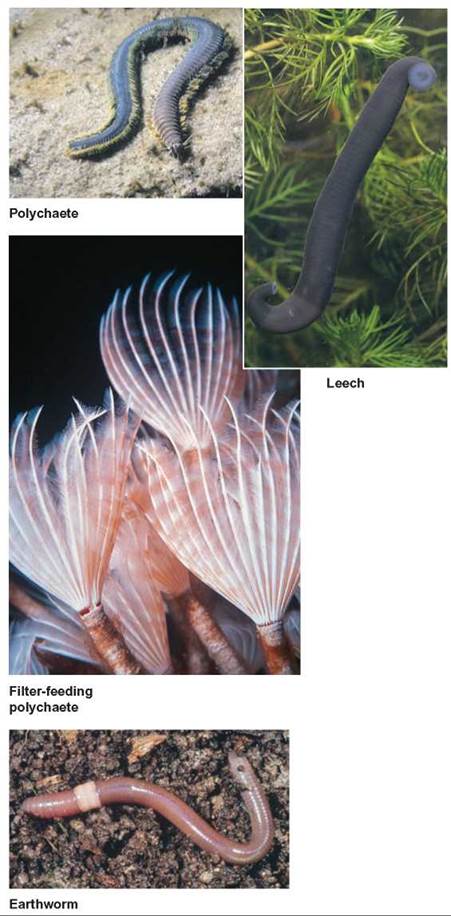CONCEPTS IN BIOLOGY
PART V. THE ORIGIN AND CLASSIFICATION OF LIFE
23. The Animal Kingdom
23.9. Annelida—Segmented Worms
The annelid worms are bilaterally symmetrical and have a body structure consisting of repeating segments (figure 23.19). Most of the segments are very similar to one another, although there is usually some specialization of anterior segments into a head, and there may be specialization related to reproduction and digestion. Each segment has a coelomic cavity. They have well-developed muscular, circulatory, digestive, excretory, and nervous systems. There are three major types of annelid worms (figure 23.20).

FIGURE 23.19. Annelid Structure
An earthworm shows the major features of annelid structure. Annelids are bilaterally symmetrical, segmented, and have complex organ systems and a coelom.

FIGURE 23.20. Annelid Diversity
There are three major types of annelid worms. Polychaete worms are primarily marine worms. Some live in tubes and obtain food by filtering water. Others are free to move and are omnivores or carnivores. Oligochaetes (earthworms) burrow through soil and eat organic matter. Leeches either are carnivores or suck the blood of other animals.
Polychaetes are primarily benthic, marine worms that have paddlelike appendages on each segment. They have a well-developed head region with sense organs and a mouth. Some live in tubes and are filter feeders. Others burrow in mud or sand; some swim in search of food. Most polychaetes have separate sexes and release eggs and sperm into the ocean, where fertilization takes place. The fertilized egg develops into a ciliated larva known as a trochophore larva; it is planktonic and eventually metamorphoses into the adult form of the worm.
Oligochaetes live in moist soil or freshwater. The most commonly seen members of this group are the various kinds of earthworms. They differ from polychaetes in that they do not have appendages and a well-developed head region. They are also hermaphroditic (have both sets of sex organs in the same individual). Mating between two earthworms results in each receiving sperm from the other. Earthworms are extremely important soil organisms. They eat organic matter in the soil or come to the surface to eat dead leaves and other organic matter. As they burrow through the soil, they create spaces, which allow water and air to penetrate the soil. They are also important food organisms to many other animals.
Leeches live in freshwater or moist terrestrial environments. They have suckers, which allow them to hold on to objects. Some are free-swimming carnivores, but many feed on the blood of various vertebrates. They attach to their victims, rasp a hole through the skin, and suck blood. They produce an anticoagulant, which aids in their blood-feeding lifestyle.
23.9. CONCEPT REVIEW
23. List three structural characteristics of annelids.
24. What are the three kinds of segmented worms?